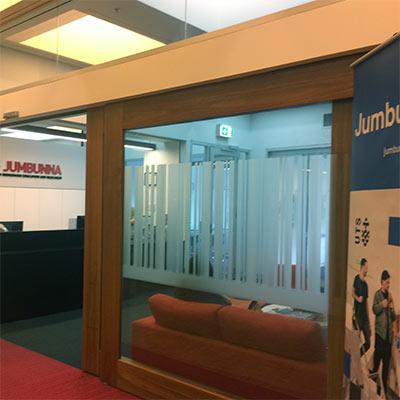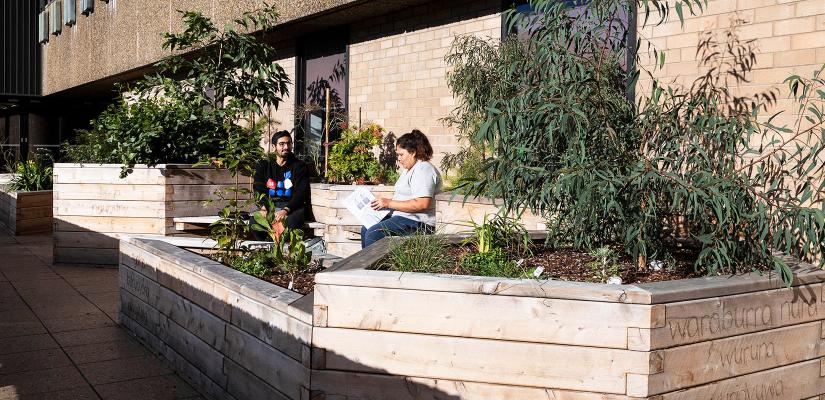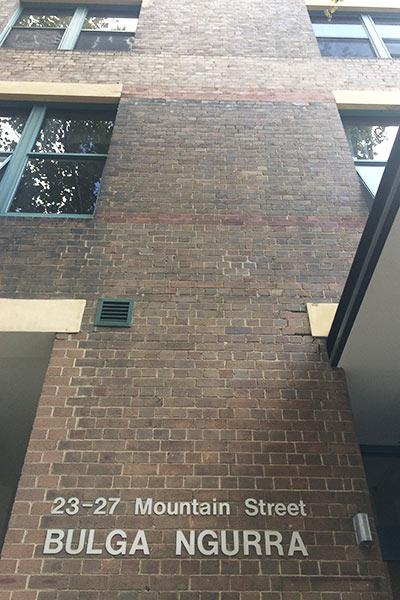In 2019, the International Year of Indigenous Languages, we celebrate the Indigenous names used across the UTS campus and provide a guide to their meaning and significance.
The UTS campus at Ultimo stands on ancestral lands of the Gadigal people of the Eora Nation, something that has inspired the names of a number of our student-focused facilities.
With UTS to open a groundbreaking Indigenous residential college by 2023, reinforcing the university’s commitment to Indigenous higher education and community connection, Indigenous language, culture and history will be even more deeply embedded in our campus and university community. But right now, where can we find Indigenous names on campus – and what do they mean?
Jumbunna
Meaning: A place to talk and learn

Jumbunna means a place to talk and learn.
Could there be a better name for the UTS Institute for Indigenous Education and Research than Jumbunna, which comes from an eastern Kulin language in Victoria. This welcoming shared space for Indigenous students and staff recognises that some may be far from home. As well as finding a friendly face or two, students visiting Jumbunna can access help to confront personal and academic challenges so that they can make the most of their time on campus.
Where to find Jumbunna: Take the escalator to level 6 of the UTS Tower and head towards the north (Alumni Green) side of the Building. Interestingly, Jumbunna is located right next to the next place on our list.
Aboriginal cultures are the oldest continuing cultures in the entire world, and keeping our languages alive is something that is important for all Australians.
– Shannan Dodson, UTS Communications Manager, Indigenous Leadership and Engagement
Waraburra Nura
Meaning: Happy Wanderer’s Place
Wandering into the Waraburra Nura Indigenous plant garden on level 6 of the UTS Tower would make anyone happy. The name derives from the Dharug and Dharawal words of the Sydney region, and the sunny terrace overlooking Alumni Green is filled with wooden planter boxes showcasing native plants that have supported the original inhabitants of the Sydney basin for millennia. More than that, the planter boxes feature key words in Dharug and Dharawal that reflect the plants’ uses and encourage visitors to enjoy the garden.
Where to find Waraburra Nura: It’s a little hidden so just make your way to level 6 of the Tower and find the double doors to the left of Jumbunna. They lead directly out to the garden so wuruna (go outside).

The name of the Waraburra Nura Indigenous plant garden comes from Dharug and Dharawal words.
Yura Mudang
Meaning: Where students live
Yura Mudang is most definitely where students live – 720 of them, in fact. The name comes from Gadigal language. When the residence was built in 2011, Indigenous students at UTS were invited to propose names, which went to a vote following consultation with an Aboriginal Elder. After receiving the highest vote, Yura Mudang was recommended to the Elder, the Aboriginal Land Council and the UTS Council – all of which approved the name. Today, the high-rise block is known for its excellent communal facilities, including a rooftop terrace with district views.
Where to find Yura Mudang: It rises 13 storeys above Building 6, with an entry off The Goods Line.
Gumal Ngurang
Meaning: Friendly Place
Situated in the bustling Quadrant development on Broadway, this friendly and sociable, 252-bed student accommodation block is close to campus, as well as the Broadway shopping centre and Central Park. With plenty of social drawcards, including barbecues, a pool table, table tennis facilities, and a large rooftop terrace, Gumal Ngurang – from Gadigal language – is aptly named.
Where to find Gumal Ngurang: From the UTS Tower, walk west along Broadway until you come to the entrance to the Quadrant. Gumal Ngurang is just around the corner on the right.

Bulga Ngurra's name refers to its location in Mountain St.
Bulga Ngurra
Meaning: Mountain Camp
Given its location on Mountain St, Ultimo, Bulga Ngurra’s Gadigal name makes perfect sense. This student residence accommodates around 119 students from around the globe in a centrally located and well-appointed facility. Barbecues, table tennis and pool tables and even a piano for the musically minded are just some of the attractions.
Where to find Bulga Ngurra: Bulga Ngurra is on the corner of Mountain and Glebe streets, just a few blocks from both the UTS campus and Broadway shopping centre.
Geegal
Meaning: Shelter
Apartments in this homely 57-student housing block are clustered around a courtyard that invites interaction among residents. In addition to a common area, with outdoor tables, table tennis facilities and a BBQ, Geegal – from Gadigal language – has a herb and vegetable garden for green-fingered students.
Where to find Geegal: Located in Darlington, a couple of blocks from Cleveland St, Geegal is well located for Newtown and Chippendale as well as the UTS campus.
Baya Ng'ara Nura Learning Place
Meaning: A place to read, listen, hear and think
Named in Dharug, the language of the Eora nation – Baya (Read), Ng'ara (Listen, Hear, Think), Nura (Place or Country) – Baya Ng'ara Nura is a welcoming study space in the UTS Library where Indigenous students can access learning resources and support.
Where to find Baya Ng'ara Nura: From the Quay St entry to the UTS Library, make your way past the Enquiries/Loans Desk to Baya Ng'ara Nura in the back left-hand corner, adjacent to the Events Space.
Once, around 300 to 700 Aboriginal languages flourished across Australia. Today only around 13 of these are still spoken by children. This makes the significance of keeping key words alive on campus even more important – especially in the Year of Indigenous Languages (IYIL). Languages are essential not only for communication but for education, social integration and development, and capturing our identity, cultural history, traditions and memories, according to IYIL.
Shannan Dodson, UTS Communications Manager, Indigenous Leadership and Engagement, agrees, explaining why languages are so important. “Janu junu ngarrungunil yangarrburlan Rubibi gabu (my family come from Broome country) in Western Australia. For us the key to a good life is our sense of liyan – how we feel about ourselves, and our connection to the people around us and our country.
“We constantly strive for mabu liyan which means strong spirit/wellbeing,” she adds. “And part of this is having a connection to our country, culture and language – it makes us healthy. Living on the opposite side of the country, I continue to learn my language to feel narli mabujunu (truly wonderful/fantastic). You can learn some Yawuru today too. Ask someone Ngaji (na-gee) mingan (ming-an)?, which means ‘Hello, how are you?’
“Aboriginal cultures are the oldest continuing cultures in the entire world, and keeping our languages alive is something that is important for all Australians. It’s what makes us unique; something we can all celebrate.”

